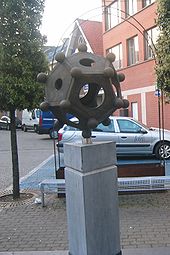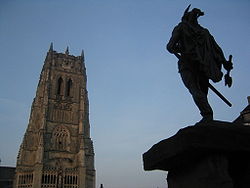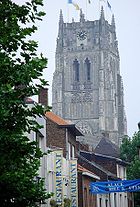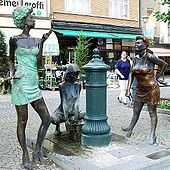- Tongeren
-
Tongeren The Basilica and the statue of Ambiorix 
Coat of armsLocation in Belgium Coordinates: 50°47′N 05°28′E / 50.783°N 5.467°E Country Belgium Region Flemish Region Community Flemish Community Province Limburg Arrondissement Tongeren Government – Mayor Patrick Dewael, acting mayor Carmen Willems (both VLD) – Governing party/ies Patrick Dewael, acting mayor Carmen Willems (both VLD) Area – Total 87.56 km2 (33.8 sq mi) Population (1 January 2010)[1] – Total 30,042 – Density 343.1/km2 (888.6/sq mi) Postal codes 3700 Area codes 012 Website www.tongeren.be Tongeren (Dutch pronunciation: [ˈtɔŋərə(n)], French: Tongres, German: Tongern) is a city and municipality located in the province of Limburg, Flemish region, Belgium. Tongeren is the oldest town in Belgium being founded in 15 BC. Inhabited in the Roman period by the Tungri, and known as Atuatuca Tungrorum, it was the administrative centre of the district under Roman rule. The city is a member of the Most Ancient European Towns Network.[2]
Contents
History
Atuatuca Tungrorum
See also: AtuatucaThe Romans referred to Tongeren as Aduatuca Tungrorum or Atuatuca Tongrorum,[3] and it was the capital of the large Roman province of Civitas Tungrorum, an area which covered modern Belgian Limburg, and at least parts of all the areas around it. Before the Roman conquests, this area was inhabited by the Eburones and possibly their neighbours the Atuatuci. The Eburones were amongst the group of Belgic tribes known as the Germani cisrhenani. Despite being known as the Germani, whether they spoke a Germanic language is debated, and the names of their tribes and their leaders were Celtic.
Caesar referred to the fort of the Eburones as Aduatuca, and this has led to a widely accepted proposal that this can be equated to Tongeren. There are counter arguments that the word "Aduatuca" was probably a general word for a fort in this region, meaning that there might have been more places with the same name, and that Tongeren shows no signs of pre-Roman occupation, nor the hilly terrain described by Caesar.[4] On the other hand, it has the same name and function as a local capital, and is in generally the right area. If it is not Tongeren itself, the Aduatuca of the Eburones might be the ancient fortification of Caestert in nearby Riemst.
During Julius Caesar’s campaigns in this part of Gaul in the 1st century BC, the Belgae revolted against the campaign of Caesar, led by the Eburones, who destroyed a legion that had demanded the right to winter amongst them in 54 BCE. Caesar reported that he sold the Aduatuci into slavery, and annihilated the name of the Eburones, many of whom however fled successfully, including Ambiorix the leader of the revolt. Instead of risking Roman lives to pursue them he invited tribes from over the Rhine, such as the Sigambri to come and plunder. This back-fired when Eburones pointed out to the Sigambri that the Romans had all the booty at Aduatuca, and were the more attractive target.
The Tungri came to dominate this area, and gave the area its Roman name. Tacitus says that Tungri was a new name for the original tribes who had inhabited this area, but many modern writers believe that the population contained a significant amount of more recent Germanic immigrants from across the Rhine. The town grew into a sizeable settlement known as Atuatuca Tungrorum. Located on the important road linking Cologne to Bavay via the relay of Liberchies, and surrounded by the fertile lands of the Hesbaye region, the settlement quickly became one of the largest Gallo-Roman administrative and military towns in the 1st century. Atuatuca Tungrorum suffered from a destructive fire during the Batavian siege in 70CE. In the 2nd century, it erected a defensive wall, portions of which can still be seen today. Typical Roman buildings were built in town, while villas and graves (tumuli) dotted the surrounding area. In the 4th century, the city became the center of a Christian diocese – one of the earliest in the Low Countries – under the influence of Saint Servatius, bishop of Tongeren, later also bishop of Maastricht, who died in 384CE.[5] It may have been destroyed by the Huns in 451CE.
Middle Ages
The Merovingian period between the 5th and the 8th century is not well documented. The building of a new church and the foundation of a chapter of canons took place in Carolingian times, at the very place where the old bishops’ houses stood, and where the basilica still stands today. The construction of the current basilica started at the beginning of the 13th century in the prevalent Gothic style of that period. Other buildings were added to the religious core of the city, including new commercial areas, hospitals and artisans quarters. The 13th century also saw the building of the medieval defensive wall, several new churches and cloisters, and the beguinage. The city became one of the “bonnes villes” (or principal cities) of the Prince-Bishopric of Liège.
From 17th century until contemporary age
In 1677, the city was burned almost entirely by Louis XIV’s troops, a catastrophe from which Tongeren never completely recovered. The rebirth of the city dates from after 1830.
Tongeren is currently the judicial capital of the Limburg province.
Main sights
 The Dodecahedron.
The Dodecahedron.
- The Béguinage, founded in 1257, listed as a UNESCO World Heritage Site since 1998. Its enclosure wall was destroyed in the 19th century: it separated the beguinage from the rest of the city and thus guaranteed peace and quiet for the small religion-inspired community. In the 17th century the beguinage counted some 300 beguines; it was also able to survive the 1677 fire that destroyed most of the city.
- The Tongeren Basilica (Onze-Lieve-Vrouwe Basiliek), built in Gothic style in the 13th century, where recent excavations have produced some of the richest archaeological finds in Flanders. Archaeological excavations have proven the presence of an edifice here starting from the 4th century, while a Carolingian prayer house existed here in the 9th century. The building of the choir of the present basilica began in 1240. Nave, transepts and side chapels were added between the 13th and 15th century. The original Romanesque tower was replaced by the present, 64 m-tall Gothic tower from 1442 until 1541. The basilica's interior is home to the statue of Our Lady of Tongeren, executed in 1475. The treasury is housed in the former hall of the Chapter and comprises one of the richest collections of religious art in Belgium.
- Church of St. Catherine, built in Gothic style in 1294 but modified later in different styles. Works of art include the 1711 pulpit by Robrecht Verburgh, the main altarpiece by Gaspar de Crayer (17th century) and a sculpture of the "Suffering Christ", donated by the beguine Anna de Floz.
- The Gallo-Roman museum, which houses Celtic gold, Roman glassware, Merovingian filigree work, and a Roman dodecahedron, an unusual Gallo-Roman object found during excavations
- The original Roman wall, dating from the 2nd century, still visible for more than 1,500 meters.
- Some of the medieval defensive towers, also still visible today
- Statue of Ambiorix, executed in 1866
Events
- The Kroningsfeesten (“Coronation Celebrations”) are organized every seven years in commemoration of the crowning of the miraculous statue of the Blessed Virgin Mary by Bishop Doutreloux in 1890. This religious procession, one of the largest and most impressive in Belgium, will take place for the seventeenth time in 2009.
- A well-attended antiques fair takes place every Sunday.
Famous inhabitants
- Ambiorix, prince of the Eburones and rebel leader against the Roman invaders; although his statue stands on the central square of Tongeren, it is unknown where he lived exactly and disputed as to whether he ever really existed, since Julius Caesar's own Commentarii de Bello Gallico is the only source to mention him (1st century BC)
- Saint Servatius, bishop of Tongeren, introduced Christianity in the Netherlands (4th century)
- Saint Helier, ascetic hermit and patron saint of Jersey (6th century)
- Radulph of Rivo, historian and liturgist (d. 1403)
- Honoré Gabriel Riqueti, comte de Mirabeau, French politician (1749–1791)
- Valentinus Paquay, Roman Catholic beatified priest, also known as "het heilig Paterke van Hasselt" (the holy priest [diminutive] of Hasselt) (1828–1905)
- Philippe Boesmans, composer (b. 1936)
- Robert Cailliau, co-inventor of the World Wide Web, together with Tim Berners-Lee (b. 1947)
- Patrick Dewael, politician, former Minister President of Flanders, and mayor (b. 1955)
International relations
See also: List of twin towns and sister cities in BelgiumTwin towns — Sister cities
Tongeren is twinned with:
 Arlon, Belgium
Arlon, Belgium Doornik, Belgium
Doornik, Belgium Heerlen, Netherlands
Heerlen, Netherlands Kalisz, Poland
Kalisz, Poland Maastricht, Netherlands
Maastricht, Netherlands
It is also a partner city of:
 Rome, Italy
Rome, Italy
Other relations
Sports
Women's volleyball club Datovoc Tongeren plays at the highest level of the Belgian league pyramid.
References
- Notes
- ^ Population per municipality on 1 January 2010 (XLS; 221 KB)
- ^ MAETN (1999 [last update]). "diktyo". classic-web.archive.org. http://classic-web.archive.org/web/20051022022345/http://www.argos.gr/diktyoe.htm. Retrieved 19 May 2011.
- ^ Gysseling, Maurits (1960), Toponymisch Woordenboek van België, Nederland, Luxemburg, Noord-Frankrijk en West-Duitsland, http://www.wulfila.be/tw/facsimile/?page=77
- ^ Vanderhoeven, Alain; Vanderhoeven, Michel (2004), "Confrontation in Archaeology: Aspects of Roman Military in Tongeren", Archaeology in confrontation: aspects of Roman military presence in the northwest, Ghent University, p. 143, http://books.google.com/books?id=zY4g1kfWvCMC&pg=PA143
- ^ http://www.livius.org/se-sg/servatius/servatius.html
External links
- Official website - Only available in Dutch
- Roman Tongeren
- Gallo-Roman museum
Hasselt As · Beringen · Diepenbeek · Genk · Gingelom · Halen · Ham · Hasselt · Herk-de-Stad · Heusden-Zolder · Leopoldsburg · Lummen · Nieuwerkerken · Opglabbeek · Sint-Truiden · Tessenderlo · Zonhoven · Zutendaal
Maaseik Bocholt · Bree · Dilsen-Stokkem · Hamont-Achel · Hechtel-Eksel · Houthalen-Helchteren · Kinrooi · Lommel · Maaseik · Meeuwen-Gruitrode · Neerpelt · Overpelt · PeerTongeren Categories:- Populated places established in the 1st century BC
- Municipalities of Limburg (Belgium)
- Populated places in Belgium
- World Heritage Sites in Belgium
Wikimedia Foundation. 2010.





